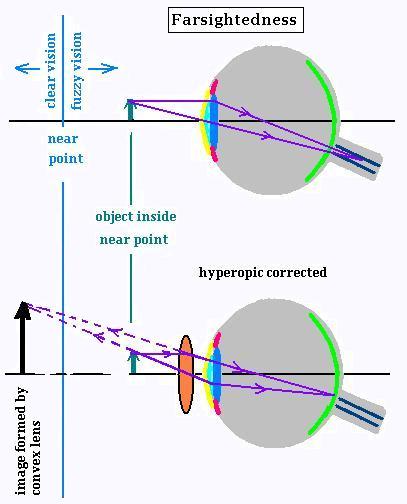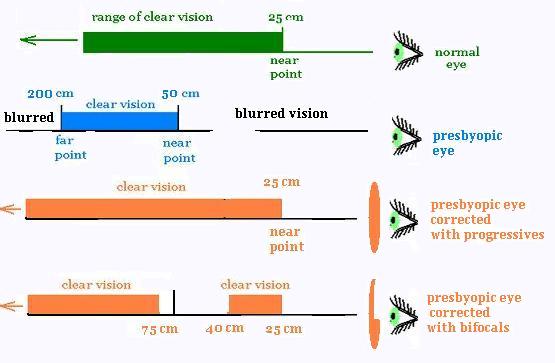Contents
ScientificSentence
© The scientific sentence. 2010
| Optics: Optical instruments:
the optics of an eye
1. Introduction:
A pair of glasses or contact lenses correct
a faulty eyesight to produce normal vision.
The fundamental elements of an eye are illustrated
in the following figure:

The eye is an optical instrument. The retina contains
millions of rods and cones that, when simulated by light,
send electrical impulses along to the optic nerve to
the brain.
The most part of refracted light needed to produce
an image occurs at the air-cornea interface. The index of refraction
of air is 1.00 and the index of refraction of the cornea is
about 1.38. At the aqueous humor, the index of refraction is
1.33, next the lens has an index of refraction of 1.40, and the
vitreous humor 1.34. The lens contributes for only about a quarter
pf the total refraction.
Altering the shape of the lens with the ciliary muscles, changes
its focal length. When we see distant objects, the ciliary muscles
are relaxed and the lens is relatively flat and causes a little
refraction, then the focal length is at its greatest. When we
view nearby objects, the ciliary muscles are tensed to give
the lens more curvature, and the lens shortens its focal length,
then more refraction. The process of changing the shape of the lens
and hence adjusting its focal length is called accommodation.
A normal human eye produces sharp images of objects
between about 25 cm and infinity. A different
situation is the case of visual defects or a reduction
in focusing ability gotten with advancing age.
The three most common problems are nearsightedness,
farsightedness, or astigmatism. The nearsightedness is
the ability to focus on nearby objects, the farsightedness the
ability to focus on far away objects, and the astigmatism is the defect,
in which the eye is unable to sharply focus an entire image at
any distance.
2. near and far point

There is a limit on how the eye can focus. An object closer to
the eye than a certain point called near point appears blurry.
For young people, it is about 25 cm. It increases with age, and
can be about 40 cm for people of age 40. It becomes about 500 cm
in later years.
The far point is the greatest distance from the
eye an object can be and still remains on focus. As we see
stars, the normal far point is infinity. For the intensity of the
light received by the eye, the iris plays the role
of a diaphragm that contracts in bright light and dilates in dim
light.
3. Nearsightedness

For a normal vision (clear vision from 25 cm to infinity), when the
ciliary muscles are relaxed, an object at infinity is in focus. For
a near-sighted (myopic), the relaxed eye focuses only within
a finite distance from a certain point toward the eye , this point is
called the far point.
The near objects are focused, whereas objects
beyond the far point are fuzzy (blurred). In this case the eye converges
the light in too short distance. To correct this excess of convergence effect,
we need a diverging (concave) lens, placed in front of the aye, to make images
fall again on the retina. At this effect, a blurry object at the infinity will
be viewed a the related far point. The concave lens will produce the image of
an object at infinity (distant object) at the myopic's far point, therefore,
the relaxed nearsighted relaxed eye can now focus on the object.

Example: Extended vision
A nearsighted has a far-point at 353 cm from the eye. If correcting
glasses (thin diverging concave lenses) are set at 3.00 cm from the
eye. What is the focal length of these lenses that will allow focusing
on distant object.
The image of the distant object will be
placed at the far-point = - q
distant point = infinity.
According to the the Gaussian lens formula:
1/f = 1/p + 1/(- q) gives:
1/f = 0 - 1/q = - 1/(353 - 3.00) = - 1/350 (cm-1)
4. Farsightedness

For a normal vision (clear vision from near-point 25 cm to infinity),
when the ciliary muscles are relaxed, an object at the near point is
in focus. For a far-sighted (hyperopic), the relaxed eye
focuses only within a finite distance from a certain point, called
the near point toward infinity.
The near or closer objects
are blurry, whereas objects beyond the near point are focused. The
near-point for an hyperopic if much farther from the eye than the
near-point's normal person, as a result, a farsighted person is
unable to read clearly. In this case the eye converges the light
in too long distance. Rays from an object inside the near point
are brought to a focus behind the retina.
To correct this insufficiency
of convergence effect, we need a converging (convex) lens, placed in
front of the aye, to make images fall again on the retina. At this
effect, a blurry object inside the near-point will be viewed beyond
this near point where the vision is clear. The convex lens will
produce the image of an object inside the near-point (near object)
beyond the hyperopic's near point, therefore, the relaxed farsighted
relaxed eye can now focus on the object
with ease.

Example: Far sight better vision
A farsighted person wears glasses at 2.00 cm from his eyes,
enabling him to read a book held at a distance 25.00 cm from
his eyes. His near-point is 60.00 cm.
His glasses are converging convex lenses of focal distance
f. We have:
1/f = 1/p + 1/q = 1/(25 - 2) + 1/(- (60 - 2)) = 1/23 - 1/58 = 0.026
Therefore f = 38.11 cm
The refractive power is 1/f (in m) = 2.6 diopters
5. Astigmatism
Astigmatism is usually produced by an asymmetry of the cornea
which causes the effective focal length of the eye to behave differently
for rays in the horizontal and vertical planes. A lens in the form of a
cylinder section can be used to correct astigmatism.
|
|